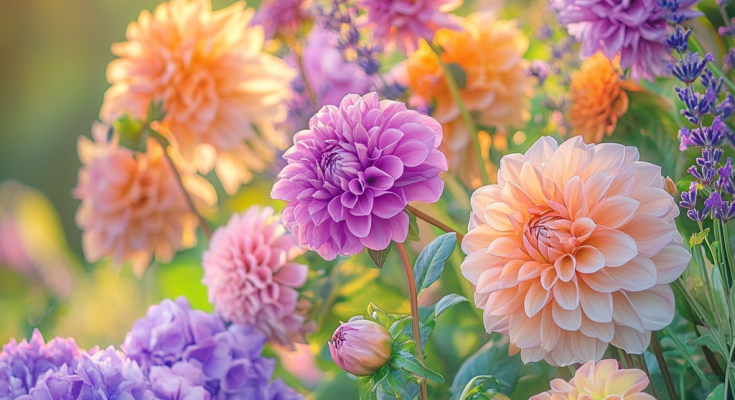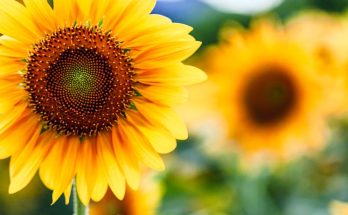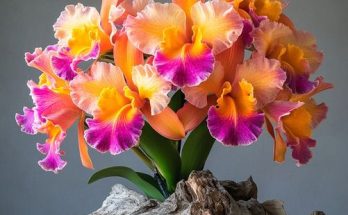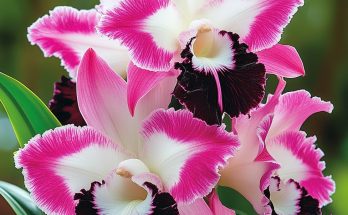Planting, Growing, and Caring for Dahlias
About Dahlia Flowers
Picking a favorite dahlia is like going through a button box! The flowers can range in size from petite 2-inch lollipop-style pompoms to giant 15-inch “dinner plates.” Most varieties grow 4 to 5 feet tall. Dahlias grow in a wide range of beautiful colors, including white, yellow, orange, pink, dark pink, red, dark red, lavender, purple and black, light blend, bronze, flame, dark blend, variegated and bicolor!
Dahlia is a genus of tuberous plants that are members of the Asteraceae family. The tubers are planted in the ground in late spring (around the month of May) and generally flower from July to the first autumn frosts. Dahlias are perfect for a border garden and make lovely cut flowers. Growing vegetables? Put a row of dahlias on the border, where they will not shade your edibles.
Are Dahlias Perennials or Annuals?
Dahlias are tender perennials in their native warm climate of Mexico. In the United States, they are considered perennials in hardiness Zones 8 and higher. See the USDA hardiness zone page.

However, in colder regions (Zones 7 and lower), dahlias are treated as annuals. That said, some gardeners have had luck keeping the dahlias in the ground in Zones 6 and 7.
Luckily, cold-weather gardeners can also just dig up the tubers after the first fall frost and store them in the garage until spring. Learn how to dig up dahlias in the guide below.
Planting
Dahlias thrive in 6 to 8 hours of direct sun, especially morning sunlight, and they benefit from protection from wind. Consider their size at maturity when planting. They grow best in rich, well-draining soil with a pH of 6.0 to 7.5. Amend heavy clay soil with aged manure or compost to lighten and loosen the soil texture for better drainage.
When to Plant Dahlias
- Dahlias will not tolerate cold soil. Plant when the soil reaches 60ºF (15°C) and any danger of frost has passed.
- Planting dahlias a few days after tomatoes are planted in the ground is a good rule of thumb.
- Some gardeners start tubers indoors in containers a month ahead to get a jump on the season. Medium- to dwarf-size dahlias will do well in containers.
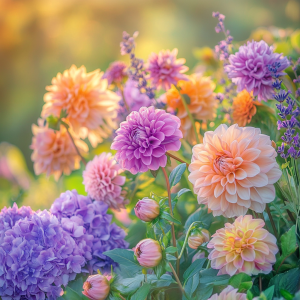
How to Plant Dahlias
Avoid planting dahlia tubers that appear wrinkled or rotten. Pink “eyes” (buds) or a little green growth are good signs.
- Plant large dahlias and those grown solely as cut flowers in a dedicated plot where they will be free from competition from other plants. Set tubers in rows spaced 3 feet apart. If you plant dahlias about 1 foot apart, they make an excellent flowering hedge and will support each other.
- Plant medium- to low-height dahlias, usually in the 3-foot tall range, among other summer flowers. Set them 2 feet apart.
- Plant the smallest bedding dahlias, grown from seed, 9 to 12 inches apart.
Start by digging a 6- to 8-inch deep hole to plant the tubers. It also helps to mix some compost and a handful of bonemeal into the planting hole. Otherwise, do not fertilize at planting.
- Set a tuber into the hole with the growing points, or “eyes,” facing up.
- Do not break or cut individual dahlia tubers (as you would with potatoes).
- Cover the tuber with 2 to 3 inches of soil. (Some say 1 inch is adequate.)
- As the stem sprouts, fill in with soil until it is at ground level.
- Do not water the tubers right after planting. This encourages rot. Wait until the sprouts have appeared above the soil, then water.
- Do not spread mulch. Dahlias prefer sun on their roots, plus mulch harbors slugs.
- Tall, large-flower cultivars require support. Place 5- to 6-foot stakes around plants and tie stems to them as the plants grow.
- Dahlias begin blooming about 8 weeks after planting.
Growing Dahlias in Containers
Medium- to dwarf-size dahlias do well in containers that have drainage and are big enough to support the plant at maturity. Generally, a 12×12-inch container will suffice.
- Use a soilless mix and co-polymer moisture-retaining crystals, per the package’s guidance.
- Follow the depth requirements.
- Cover the tuber with a few inches of soil-crystal mix.
- Spray water on the tuber, if necessary, until growth starts.
- Do not water if the soil is damp 1 inch below the surface.
- Fertilize through summer as directed.
- Add soil if the roots become exposed.
